Kentucky Bluegrass vs Tall Fescue: What’s The Difference?
If you’re looking to level up your turf game, you’ve come to the right place.
Two of the most popular grass types out there are Kentucky Bluegrass and Tall Fescue and they aren’t just good-lookin’.
These two grasses also play a major role in landscaping, lawns, and turf management.
Not sure which is ideal for your lawn? We can help.
Where Do These Grasses Come From?
Curious about the history of where these grasses came from? We got you.
Kentucky Bluegrass: A World Traveler
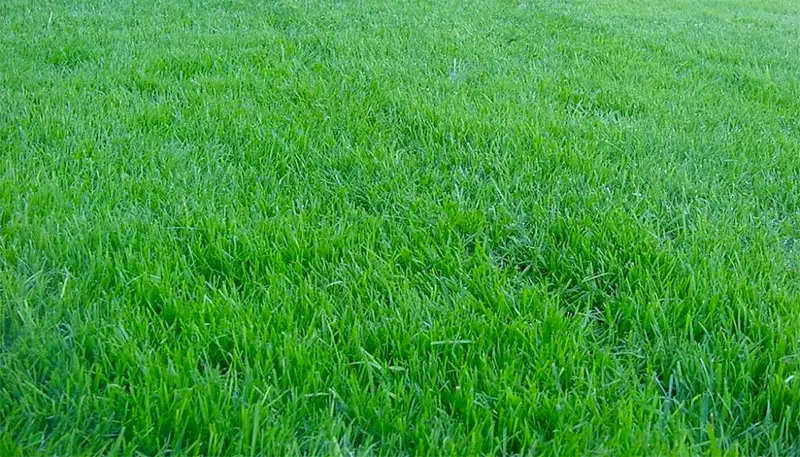
Despite its name, Kentucky Bluegrass ain’t actually from Kentucky!
This popular grass is native to Europe, Asia, and Northern Africa. It’s quite the world traveler, right?
It made its way to North America during the colonial era, and ever since, it’s been a go-to choice for lush, green lawns and pastures all over the continent.
Tall Fescue: The European Native
On the other hand, Tall Fescue has its roots (pun intended) in Europe.
This grass is a true European native and has been a staple for lawns and pastures across the pond for centuries.
Like its bluegrass buddy, Tall Fescue found its way to the US, where it’s become a popular choice for many turf enthusiasts who value its adaptability and resilience.
Physical Characteristics of Kentucky Bluegrass and Tall Fescue
Now let’s look at the physical characteristics of Kentucky Bluegrass and Tall Fescue so you can see how they stack up against each other.
Bluegrass: A True Blue Beauty
Kentucky Bluegrass is famous for its gorgeous, deep green color with a hint of blue (hence the name).
Its leaves are fine and soft, making it perfect for that barefoot walk on the lawn we all love.
Bluegrass grows in a unique way, too: it spreads by rhizomes, which are underground stems that allow the grass to form a dense, lush carpet.
This growth habit helps it fill in gaps and recover from damage, keeping your lawn lookin’ fabulous.
Tall Fescue: The Tough and Tidy Type
Tall Fescue, on the other hand, sports a slightly coarser texture and a rich, deep green color.
Its leaves are wider than those of bluegrass, but they still feel pretty nice underfoot.
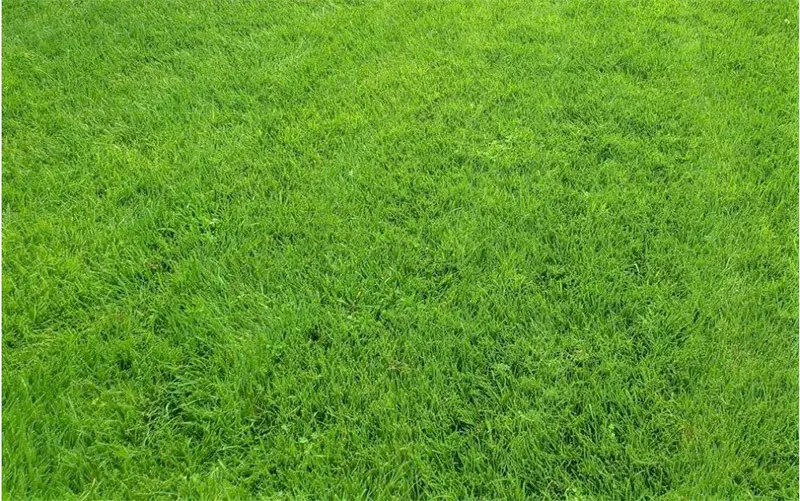
Unlike bluegrass, Tall Fescue grows in clumps or bunches, which can give your lawn a slightly different look.
The good news is that it stands up well to foot traffic and wear, so it’s great for active families or areas with lots of activity.
Climate and Soil Adaptation of Kentucky Bluegrass and Tall Fescue
Grasses can be a bit like Goldilocks – they need everything just right to grow their best.
Let’s check out the ideal climate and soil conditions for Kentucky Bluegrass and Tall Fescue, and see how they adapt to different environments.
Kentucky Bluegrass: Cool and Comfy
Bluegrass loves to chill – literally!
This grass type thrives in cool, temperate regions, making it a top choice for lawns in the northern and transition zones of the US.
It’s not a big fan of heat, so it might struggle a bit during hot, dry summers.
But don’t worry, it can bounce back when the cooler temps return.
When it comes to soil, bluegrass prefers well-drained, fertile ground.
It can be a bit of a diva, though – it doesn’t do well in heavy, poorly drained soils or in areas with a lot of shade.
So, if you’re thinking of planting bluegrass, make sure you’ve got the right conditions to keep it happy and healthy.
Tall Fescue: The Adaptable All-Rounder
Unlike its bluegrass buddy, Tall Fescue is way more adaptable to a wider range of climates.
It can handle the heat and humidity of the southern US while still performing well in cooler climates.
It’s a real all-rounder, making it a solid choice for lawns in the transition zone and beyond.
As for soil, Tall Fescue ain’t picky. It can tolerate poorly drained soils and even handle some shade like a champ.
This grass is known for its deep root system, which helps it find water and nutrients even in tough conditions.
So, if you’ve got a less-than-perfect yard or some challenging areas, Tall Fescue might be just the ticket.
Drought and Heat Tolerance of Kentucky Bluegrass and Tall Fescue
When the sun’s blazin’ and the rain’s scarce, you want a lawn that can take the heat.
So we’ll show you how Kentucky Bluegrass and Tall Fescue measure up when it comes to drought and heat tolerance.
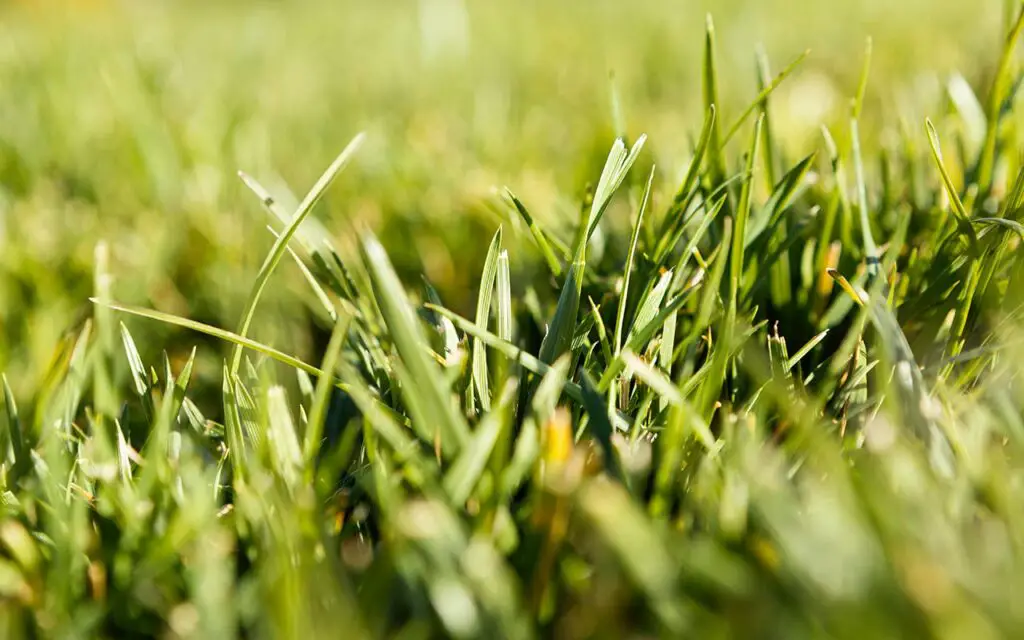
Kentucky Bluegrass: Needs a Little TLC
As we mentioned earlier, Kentucky Bluegrass isn’t the biggest fan of heat.
During hot and dry periods, it might need a little extra love and care to keep it looking its best.
Bluegrass has a tendency to go dormant and turn brown when it’s stressed, but don’t freak out – it can recover once the temperatures drop and the water returns.
To keep your bluegrass lawn looking fresh during the summer, you’ll need to water it consistently and possibly apply some supplemental irrigation.
Just remember, if you’re in an area with water restrictions, this might be a bit of a challenge.
Tall Fescue: The Tough Cookie
When it comes to drought and heat, Tall Fescue is one tough cookie.
Its deep root system allows it to find water even when the going gets rough.
This means that it can generally tolerate dry spells and high temperatures better than Kentucky Bluegrass.
That said, even the toughest grasses need a little help sometimes.
During extended periods of drought or extreme heat, you might need to give your Tall Fescue lawn a little extra water to keep it looking its best.
But overall, it’s a more low-maintenance option when it comes to dealing with heat and drought.
Disease and Pest Resistance in Kentucky Bluegrass and Tall Fescue
Nothing puts a damper on a beautiful lawn like diseases and pests.
We’ve got all the deets for you on how Kentucky Bluegrass and Tall Fescue handle these lawn enemies and what you can do to keep your grass healthy and strong.
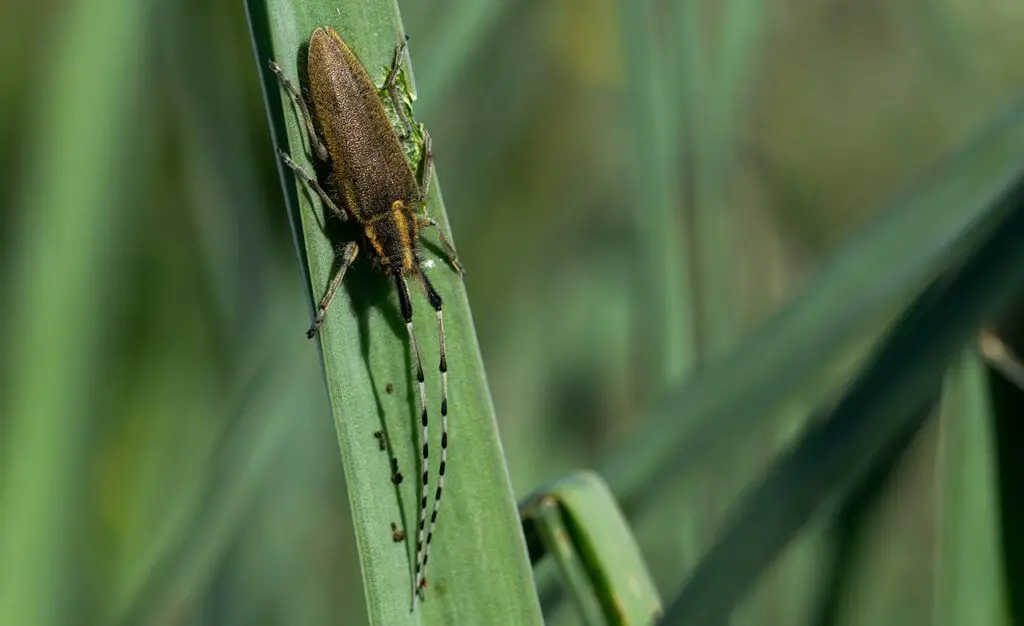
Kentucky Bluegrass: Keep an Eye Out
While Kentucky Bluegrass is a stunner, it can be a bit more susceptible to certain diseases and pests.
Some common foes include leaf spot, dollar spot, and rust, as well as pesky insects like billbugs and grubs.
But don’t stress – with a little attention and care, you can keep these problems in check.
Here’s the scoop on managing bluegrass issues:
- Regular mowing at the right height (usually around 2.5-3 inches) can help prevent disease.
- Proper watering – not too much, not too little – is key to keeping diseases and pests at bay.
- Don’t forget to aerate and dethatch your lawn to promote good air circulation and reduce the chance of disease.
- Use disease-resistant varieties of bluegrass if you’re starting a new lawn or overseeding.
Tall Fescue: The Resilient Warrior
Tall Fescue has a rep for being more resistant to diseases and pests than Kentucky Bluegrass.
Its tough nature helps it fend off problems like brown patch, pythium blight, and red thread.
It’s also less attractive to lawn-munching insects like grubs and sod webworms.
But even warriors need a little help sometimes.
Here are some tips for keeping your Tall Fescue lawn in tip-top shape:
- Mow at the right height (around 3-4 inches) to promote a healthy, disease-resistant turf.
- Water deeply and less frequently to encourage a strong root system.
- Aerate your lawn to improve soil structure and reduce compaction, which can lead to disease.
- Choose disease-resistant Tall Fescue varieties for added protection.
Maintenance Requirements for Kentucky Bluegrass and Tall Fescue
Let’s be honest – we all want a gorgeous lawn, but we don’t want to spend every waking moment fussing over it.
That’s why it’s important to know the maintenance needs of Kentucky Bluegrass and Tall Fescue, so you can choose the grass that fits your lifestyle and budget.
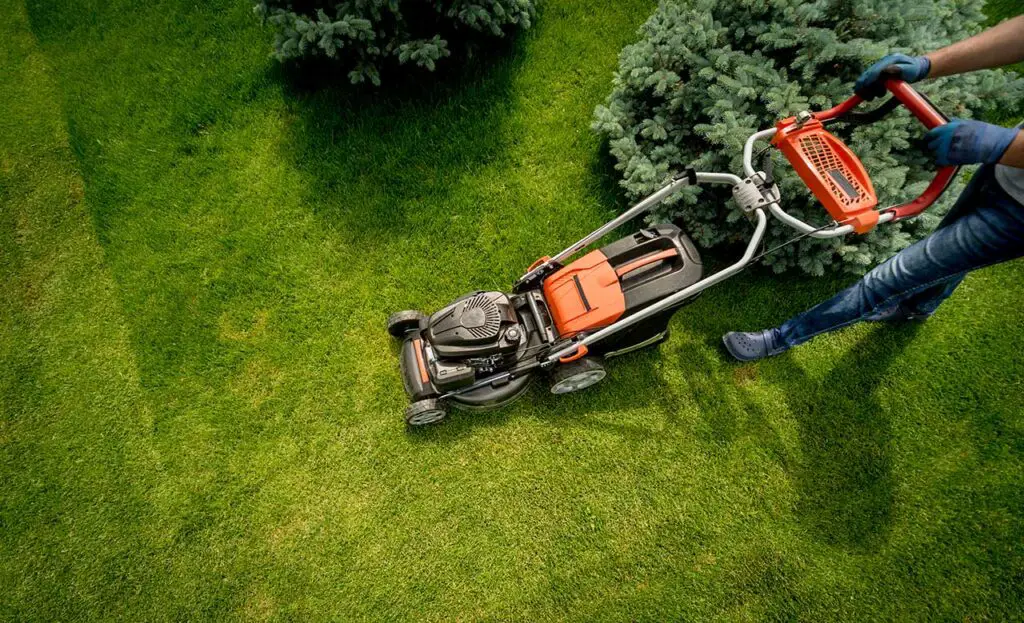
Kentucky Bluegrass: A Bit More Work, But Worth It
Kentucky Bluegrass might need a little more TLC to keep it looking its best.
Here’s what you can expect:
- Mowing: You’ll need to mow your bluegrass lawn about once a week during the growing season. Keep it at around 2.5-3 inches for the best results.
- Fertilization: Bluegrass loves its nutrients! You’ll want to fertilize it 3-4 times a year with a balanced, slow-release fertilizer to keep it healthy and green.
- Irrigation: To prevent drought stress, water your bluegrass lawn deeply and infrequently. Aim for about 1 inch of water per week, either from rainfall or irrigation.
While these maintenance tasks might require a bit more effort and cost, the payoff is a thick, lush, and beautiful bluegrass lawn that’ll make your neighbors green with envy.
Tall Fescue: Low-Maintenance Lovin’
If you’re looking for a more low-maintenance option, Tall Fescue might be right up your alley.
Here’s the rundown on its care requirements:
- Mowing: Tall Fescue doesn’t need mowing as often as bluegrass. Aim for every 10-14 days, and keep the height at around 3-4 inches.
- Fertilization: Feed your Tall Fescue lawn 2-3 times a year with a balanced fertilizer to keep it strong and vibrant.
- Irrigation: Water your Tall Fescue lawn deeply and infrequently, similar to bluegrass. It’s more drought-tolerant, but it still appreciates a good soak now and then.
By choosing Tall Fescue, you’ll enjoy a lower-maintenance lawn that can still handle the rigors of daily life while looking great.
Environmental Impact of Kentucky Bluegrass and Tall Fescue
As lawn care experts, we gotta think about the environment too.
Let’s dive into the environmental implications of Kentucky Bluegrass and Tall Fescue with deets on things like water usage, chemical inputs, and the potential for invasive species.
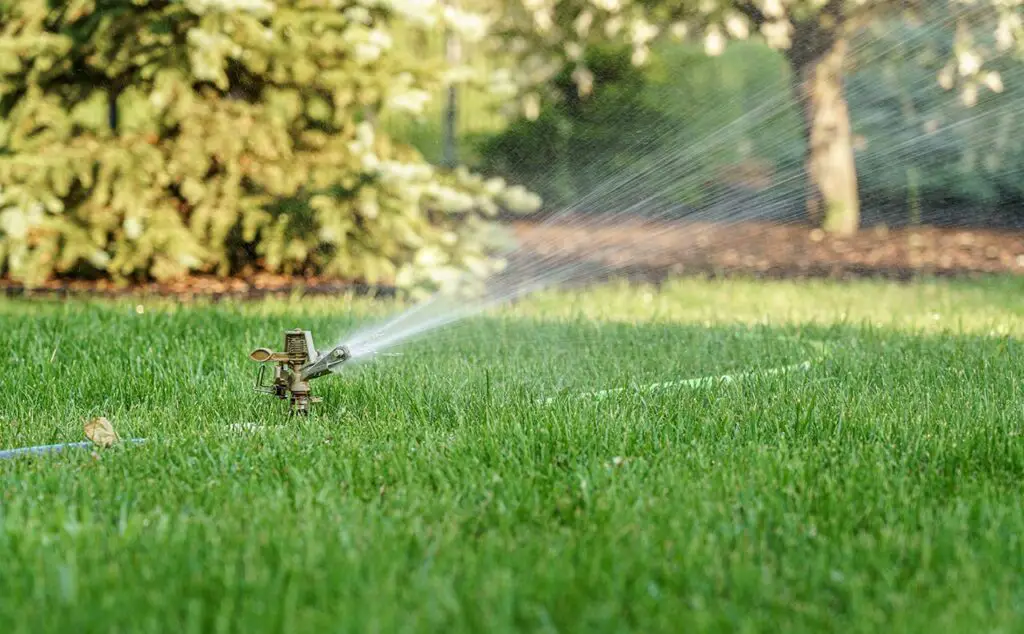
Kentucky Bluegrass: A Thirsty Beauty
While Kentucky Bluegrass looks amazing, it can be a bit of a water hog.
Its higher water requirements can be an issue in areas prone to drought or with strict water restrictions.
But don’t lose hope, there are ways to minimize its environmental impact:
- Water wisely: Use efficient irrigation systems, like drip irrigation or smart controllers, to reduce water waste.
- Choose wisely: Opt for drought-tolerant bluegrass varieties that require less water to stay green and lush.
- Chemical caution: Use slow-release, organic fertilizers and avoid overuse of pesticides to minimize chemical runoff.
With a little extra care, you can have a beautiful bluegrass lawn that’s kinder to the environment.
Tall Fescue: The Eco-Friendly Option
Tall Fescue is generally considered the more eco-friendly choice, thanks to its lower water requirements and greater adaptability.
It can handle a wider range of soil conditions and needs fewer chemical inputs to thrive.
But don’t get complacent – there are still ways to make your Tall Fescue lawn even greener:
- Water responsibly: Use efficient irrigation methods and water deeply but infrequently to promote a strong root system.
- Go organic: Use organic, slow-release fertilizers and minimize pesticide use to reduce your lawn’s environmental footprint.
- Invasive watch: While Tall Fescue isn’t typically invasive, be mindful of its spreading habits and avoid planting it near natural areas.
By choosing Tall Fescue and following these eco-friendly practices, you’ll be doing your part to keep the environment – and your lawn – in great shape.
Find Your Turf: Applications and Usage of Kentucky Bluegrass and Tall Fescue
Now that we’ve covered the nitty-gritty of these two grasses, let’s talk about where they shine.
We’ll break down the various applications and preferred usage of Kentucky Bluegrass and Tall Fescue in landscaping, lawns, sports fields, and golf courses.
Kentucky Bluegrass: The All-American Lawn Star
There’s a reason Kentucky Bluegrass is considered the classic American lawn grass – it’s versatile, beautiful, and stands up well to foot traffic.
Here’s where it excels:
- Home lawns: For that picture-perfect front yard, you can’t go wrong with Kentucky Bluegrass. Its dense, lush growth creates a carpet-like appearance that’ll have the whole neighborhood talking.
- Sports fields: It’s not just for looks – bluegrass can handle the rough and tumble of sports like soccer, football, and baseball, making it a top choice for athletic fields.
- Golf courses: Kentucky Bluegrass is often used for golf course roughs and fairways, thanks to its ability to handle foot traffic and recover quickly from wear and tear.
Whether you’re looking to impress the neighbors or host the next pickup game, Kentucky Bluegrass has got you covered.
Tall Fescue: The Tough and Adaptable Choice
If you need a grass that can handle a little adversity, Tall Fescue is your go-to.
Its resilience and adaptability make it a popular choice for a range of applications:
- Home lawns: Tall Fescue is a low-maintenance option for homeowners who want a green lawn without all the fuss. Plus, its deeper root system means it can tolerate a wider range of soil conditions.
- Sports fields: Thanks to its durability and wear tolerance, Tall Fescue is a solid choice for sports fields. It may not be as dense as bluegrass, but it can still handle the action.
- Golf courses: Tall Fescue is sometimes used on golf course roughs, especially in areas with water restrictions or harsher soil conditions. Its hardiness makes it a practical choice.
From low-maintenance lawns to tough sports fields, Tall Fescue is the grass that keeps on giving.
Pickin’ the Perfect Grass: How to Choose Between Kentucky Bluegrass and Tall Fescue
Alright, now that we’ve gone through all the details, let’s help you make the big decision.
Let us offer some guidance on how to choose the best grass type for your specific location, considering factors like climate, soil, and desired maintenance level.
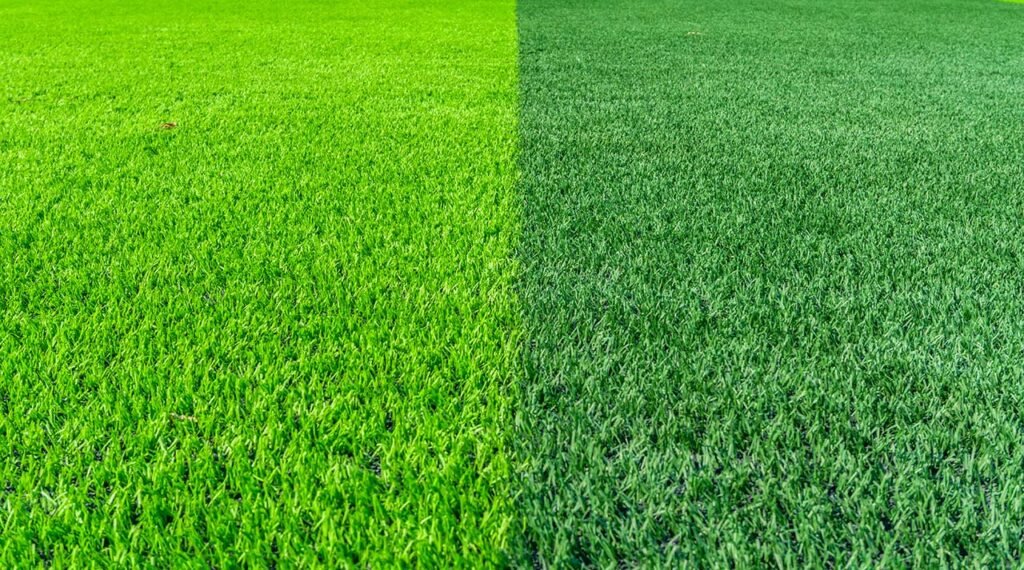
Climate Considerations: Know Your Zone
First things first – let’s talk about your local climate.
As we mentioned earlier, Kentucky Bluegrass thrives in cool, temperate regions, while Tall Fescue can handle a wider range of climates.
Here’s the breakdown:
- Cool climates: If you’re in a cooler area, either grass could work, but Kentucky Bluegrass might give you that lush, classic lawn look you’re after.
- Warm climates: For those in warmer regions, Tall Fescue is your best bet, as it’s more heat and drought tolerant.
- Transition zones: If you’re in a transition zone with both cool and warm seasons, consider a blend of the two grasses or a heat-tolerant bluegrass variety.
Soil Sitch: Diggin’ Deeper
Next up – your soil. This is a big factor when choosing the right grass, so make sure to get the dirt on your dirt:
- Well-drained soils: If you’ve got well-draining soil, either grass type will do just fine. Kentucky Bluegrass might have a slight edge in this case, though.
- Poorly drained soils: For those with poorly draining or compacted soil, Tall Fescue is the winner. Its deeper root system allows it to handle less-than-ideal conditions.
- Soil test: Don’t forget to do a soil test to get a better understanding of your soil’s pH and nutrient levels. This can help you choose the right grass and plan for proper fertilization.
Maintenance Matters: How Much Work Do You Wanna Do?
Finally, think about how much time and effort you’re willing to put into your lawn.
Are you a hands-on gardener, or more of a laid-back lawn lover? Here’s what to consider:
- Low maintenance: If you’re looking for a low-maintenance lawn, Tall Fescue is your friend. It requires less frequent mowing, watering, and fertilizing.
- High maintenance: If you don’t mind putting in the work for a stunning lawn, Kentucky Bluegrass might be worth the extra effort, with its denser, more uniform appearance.
With all these factors in mind, you should have a better idea of which grass is right for your situation.
But remember, there’s no substitute for local knowledge. Reach out to your local extension service or lawn care professionals for advice tailored to your specific region and needs.
Gettin’ Started: Establishing and Seeding Kentucky Bluegrass and Tall Fescue Lawns
Alright, you’ve made your choice – now it’s time to get down to business.
We’ve got the lowdown on how to establish and seed your new Kentucky Bluegrass or Tall Fescue lawn.
Follow our tips and best practices, and you’ll be well on your way to a gorgeous, green oasis.
Kentucky Bluegrass: Tips for a Lush Lawn
When it comes to establishing a Kentucky Bluegrass lawn, timing and patience are key.
Here are some pointers to help you succeed:
- Timing: Seed your bluegrass lawn in late summer or early fall, when temperatures start to cool and there’s less competition from weeds.
- Prep work: Make sure your soil is well-prepped, with any weeds removed, a pH level between 6.0 and 7.0, and a layer of quality topsoil spread over the area.
- Seeding: Use a broadcast spreader for even seed distribution and aim for a seeding rate of about 2-3 pounds per 1,000 square feet.
- Watering: Keep the soil consistently moist (but not waterlogged) for the first 2-3 weeks to encourage germination. After that, cut back to regular watering.
- Patience: Bluegrass can take a bit longer to establish, so don’t fret if it’s slow-going at first. Keep up with proper care, and you’ll have a lush lawn in no time.
Tall Fescue: Planting for Success
Establishing a Tall Fescue lawn is a bit more straightforward, but it still requires some know-how.
Follow these tips for a healthy, happy lawn:
- Timing: Like bluegrass, the best time to seed Tall Fescue is in late summer or early fall. You can also seed in spring, but you’ll face more weed competition.
- Prep work: Remove weeds and debris, then work the soil to a depth of 4-6 inches. Ensure your soil’s pH is between 5.5 and 7.0, and add a layer of quality topsoil if needed.
- Seeding: Use a broadcast spreader for even seed distribution, and aim for a seeding rate of about 5-7 pounds per 1,000 square feet.
- Watering: Keep the soil consistently moist for the first 10-14 days to promote germination. After that, cut back to regular watering.
- Growth: Tall Fescue will establish more quickly than bluegrass, so you should see some progress sooner. Just make sure to keep up with proper maintenance!
Kentucky Bluegrass vs Tall Fescue – The Final Showdown
Alright, folks – we’ve covered a lot of ground (pun intended) in this article. Now it’s time to wrap things up and summarize the main differences between Kentucky Bluegrass and Tall Fescue.
We’ll also highlight the benefits and drawbacks of each grass type, so you can make a well-informed decision for your lawn or turf needs.
Kentucky Bluegrass: The Good, the Bad, and the Beautiful
First up, let’s recap Kentucky Bluegrass:
- Pros: Kentucky Bluegrass is known for its lush, carpet-like appearance, making it a popular choice for a picture-perfect lawn. It thrives in cool climates and well-drained soils, and can bounce back from damage thanks to its rhizomatous growth habit.
- Cons: The downside? It’s a bit of a diva when it comes to maintenance. It requires frequent mowing, watering, and fertilizing, and it’s not the best choice for drought-prone areas or poorly drained soils. Plus, it can be more susceptible to certain diseases and pests.
Tall Fescue: Tough, Adaptable, and Low-Maintenance
Now let’s revisit Tall Fescue:
- Pros: Tall Fescue is one tough cookie. It’s more heat and drought tolerant than bluegrass, making it a better option for a wider range of climates. It’s also more adaptable to different soil types, including poorly drained soils. Plus, it’s lower maintenance – less mowing, watering, and fertilizing needed.
- Cons: The trade-off? It might not have that classic, dense lawn look that bluegrass offers. And while it’s generally more disease and pest resistant, it can still face some issues, so don’t slack on lawn care completely.
Both grass types have their own unique benefits and drawbacks, so it’s up to you to decide which one is the best fit for your specific situation, climate, and maintenance preferences.